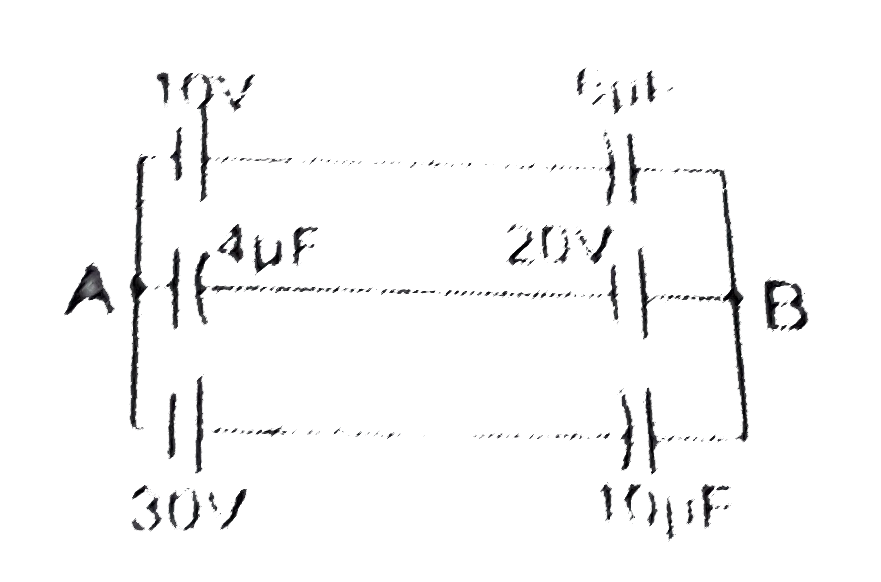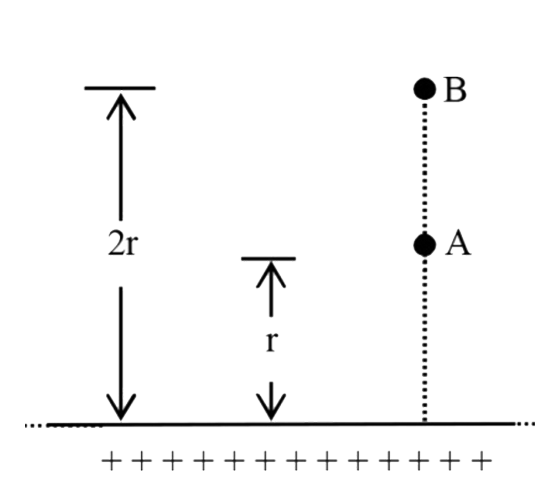An infinite plane of charge with σ=2∈0Cm2 is tilted at a 37∘ angle to the vertical direction as shown below. Find the potential difference, VA−VB in volts, between points A and B at 5m distance apart. (where B is vertically above A).
 Solution in Gujrati
Solution in Gujrati
The correct Answer is:3

E=σ2ε0=1N/C∴VB−VA=−∫→E.d→l=(σ2∈0)(5cos53∘)=3V
Topper's Solved these Questions
- MISCELLANEOUSBOOK - ALLEN CHAPTER - MISCELLANEOUSEXERCISE - Part -II Example Some worked out Examples
1 Videos
- MISCELLANEOUSBOOK - ALLEN CHAPTER - MISCELLANEOUSEXERCISE - Exercise-01
87 Videos
- MISCELLANEOUSBOOK - ALLEN CHAPTER - MISCELLANEOUSEXERCISE - Question
1 Videos
- KINEMATICS (MOTION ALONG A STRAIGHT LINE AND MOTION IN A PLANE)BOOK - ALLEN CHAPTER - KINEMATICS (MOTION ALONG A STRAIGHT LINE AND MOTION IN A PLANE)EXERCISE - BEGINNER S BOX-7
8 Videos
- PHYSICAL WORLD, UNITS AND DIMENSIONS & ERRORS IN MEASUREMENT BOOK - ALLEN CHAPTER - PHYSICAL WORLD, UNITS AND DIMENSIONS & ERRORS IN MEASUREMENT EXERCISE - EXERCISE-IV
7 Videos
Similar Questions
For spherically symmetrical charge distribution, electric field at a distance r from the centre of sphere is →E=kr7→r, where k is a constant. What will be the volume charge density at a distance r from the centre of sphere?
View SolutionA stone is dropped into a quiet lake and waves move in circles speading out radially at the speed of 5 cm/s. At the instant when the radius of the circular wave is 8cm, how fast is the enclosed area increasing?
View SolutionA simple pendulum of length l and bob mass m is hanging in front of a large nonconducting sheet having surface charge density σ. If suddenly a charge +q is given to the bob & it is released from the position shown in figure. Find the maximum angle through which the string is deflected from vertical .
 .
.
View SolutionA football player kicks a ball at an angle of 30∘ with an initial speed of 20 m/s. Assuming that the ball travels in a vertical plane, calculate (a) the time at which the ball reaches the highest point (b) the maximum height reached (c) the horizontal range of the ball (d) the time for which the ball is in the air, (g=10m/s2)
View SolutionAssertion : Gravitational forces do not depend on the medium between the masses.
Reason : Mediating particle responsible for gravitational force is graviton.
View SolutionThree concentric spherical metallic shells A, B, and C of radii a,b, and c(a lt b lt c) have surface charge densities sigma, -sigma and sigma , respectively. If V_(A), V_(B) and V_(C) are potential of shells A, B and C, respectively, match the columns {:("Column A",,,"Column B"),(a. V_(A),,i.,sigma/epsilon_(0)[(a^(2)-b^(2)+c^(2))/c]),(b. V_(B),,ii.,sigma^(2)/epsilon_(0)[a^(2)/b-b+c]),(c. V_(C),,iii.,sigma/epsilon_(0)[a-b+c]):}
View SolutionFind the potential difference Va−Vb between the points (1) and (2) shown in each part of Fig.

View SolutionThe potential difference (VA−VB) between the point A and B in the given figure is

View SolutionTwo points A and B located in diametrically opposite directions of a point charge of +2μC at distances 2.0 m and 1.0 m respectively from it. Determine the potential difference VA−VB
View SolutionFind the potential difference between points A and B (V_(B)-V_(A)) in the network
View SolutionFind the potential difference between the points A and B (VA−VB) as shown in figure. (Initially all the capacitors are uncharged)

View SolutionFind the potential difference Va−Vb between the points a and b shown in each part of the figure.

View SolutionAn infinite thin non - conducting sheet has uniform surface charge density sigma . Find the potential difference V_(A)-V_(B) between points A and B as shown in the figure. The line AB makes an angle of 37^(@) with the normal to the sheet. (sin 37^(@)=(3)/(5))
View SolutionAn infinitely long line of linear charge density λ is shown in the figure. The potential difference VA−VB between the two points A and B is

View SolutionTwo points A and B located in diametrically opposite directions of a point charge of +2μC at distances 2.0 m and 1.0 m respectively from it. Determine the potential difference VA−VB
View SolutionThe potential difference (V_(A) - V_(B)) between the point A and B in the given figure is
View Solution
